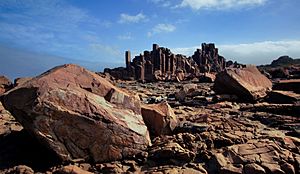Bombo Headland Quarry Geological Site facts for kids
Quick facts for kids Bombo Headland Quarry Geological Site |
|
|---|---|
 |
|
| Location | Princes Highway, Bombo, Municipality of Kiama, New South Wales, Australia |
| Owner | Department of Planning and Infrastructure; Sydney Water |
| Official name: Bombo Headland Quarry Geological Site; Bombo Quarry | |
| Type | state heritage (landscape) |
| Designated | 2 April 1999 |
| Reference no. | 177 |
| Type | Geological site or area |
| Category | Landscape - Natural |
| Lua error in Module:Location_map at line 420: attempt to index field 'wikibase' (a nil value). | |
The Bombo Headland Quarry Geological Site is a really cool place in Bombo, Australia. It used to be a quarry, which is a place where people dig out rocks. Now, it's a special geological site. It's also called Bombo Quarry. This site is so important that it's listed on the New South Wales State Heritage Register. This means it's protected because of its unique rocks and history.
Contents
Why is Bombo Headland Quarry special?
The Bombo Headland Quarry is important for many reasons. It helps scientists learn about Earth's past. It also shows amazing rock formations.
How did Bombo Quarry become a protected site?
In 1979, some geologists (rock scientists) from Australia noticed how unique Bombo Quarry was. Dr. Suzanne Wass from Macquarie University helped explain its importance. At that time, the quarry was owned by a water company. They wanted to build a water treatment plant there.
But because of its special rocks, the site needed protection. After many talks, a special order was put in place in 1983. This order made sure the site would be kept safe. In 1999, it was officially added to the State Heritage Register.
Did you know? This quarry even appeared in the movie Mighty Morphin Power Rangers: The Movie! It was shown as part of a planet called Phaedos.
What kind of rocks can you see at Bombo Headland?
At Bombo Headland, you can see two main types of rock. These rocks formed a very long time ago, during the Late Permian period. This was about 250 million years ago!
The Kiama Sandstone
One type is called the Kiama Sandstone. It forms a narrow platform near the ocean. You can also see it in the cliffs. This sandstone is reddish-brown. This color comes from a mineral called haematite, which is a type of iron oxide.
The Bombo Latite
Above the sandstone, you'll find another rock called Bombo Latite. This rock is usually grey-black. It's a type of volcanic rock. It has a cool feature called "columnar jointing." This means the rock has formed into tall, pillar-like shapes. Some of these columns are 5 meters (about 16 feet) tall!
Near the sea wall, you can see cross-sections of these columns. They look like big, round shapes, 1 to 2.5 meters (3 to 8 feet) wide. This makes the area look a bit like the famous Giant's Causeway in Ireland.
The Bombo Latite often has small holes. These holes formed from gas bubbles when the rock was still hot lava. It also has visible crystals, which makes it look "porphyritic."
Other interesting rock features
You might also see "agglomerates" in some parts of the quarry. These are rocks made of different volcanic fragments stuck together. They look a bit messy compared to the smoother latite.
At the top of the quarry, you can see weathered latite. This is rock that has changed color and texture from being exposed to the weather. It still has the same crystal pattern.
Dykes and deep Earth rocks
The Bombo Latite also has cracks filled with other types of volcanic rock. These are called "dykes." They formed when magma (melted rock) from deep inside the Earth pushed its way into cracks. These dykes are interesting because they sometimes contain "xenoliths." These are pieces of other rocks that got picked up by the magma.
Some of these xenoliths are very special. They are believed to be fragments of the Earth's mantle. The mantle is a layer of hot, dense rock about 80 kilometers (50 miles) below the surface. Finding these pieces helps scientists learn what the inside of our planet is made of!
Why is this site important for heritage?
The Bombo Headland Quarry Geological Site is very important for science and education.
Unique rock samples
The dykes at Bombo are unique. They contain special minerals and rock pieces that aren't found together anywhere else in the world. These pieces give us clues about what's deep inside the Earth.
Earth's magnetic history
The Bombo Latite itself is also famous worldwide. It helped scientists understand something called the "Kiaman Magnetic Interval." This was a time in Earth's history when the North and South magnetic poles were flipped! Like other rocks from the Permian age, the latite shows this reversed magnetism. This discovery, named after nearby Kiama, helps scientists match up rock layers from different continents.
Educational and scenic value
This area is also great for learning. It's a natural classroom for geology students and anyone interested in rocks. Plus, it's a very beautiful place. It has a lot of potential for people to visit and enjoy the scenery.
The Bombo Headland Quarry Geological Site was officially listed on the New South Wales State Heritage Register on 2 April 1999.
Images for kids


